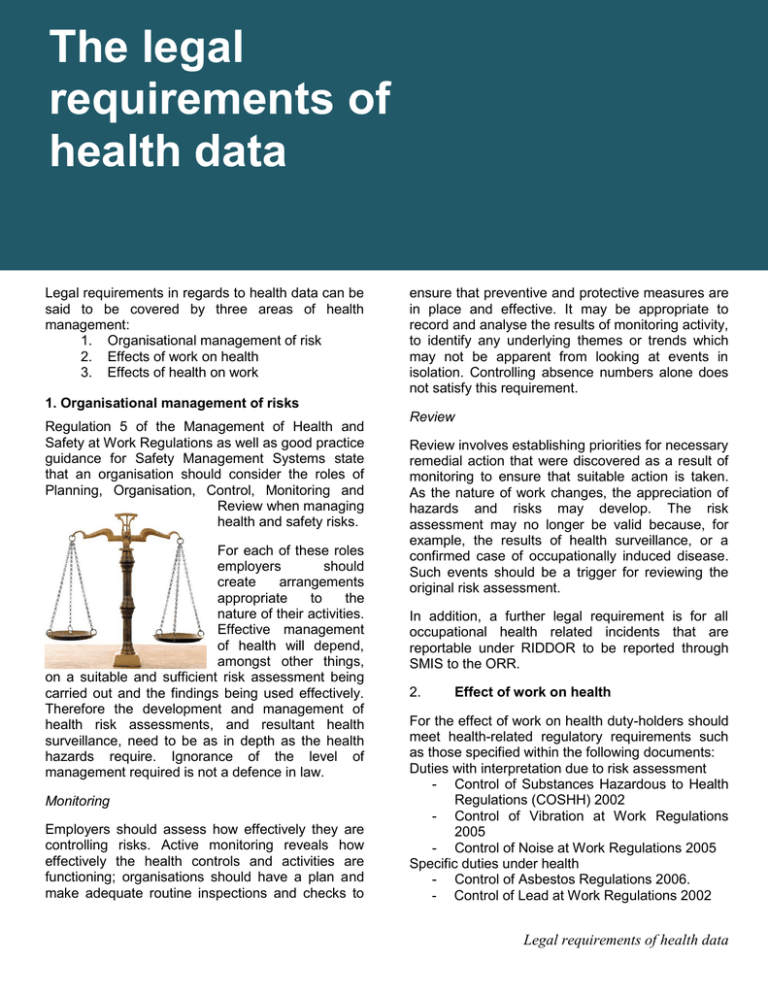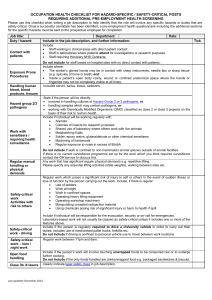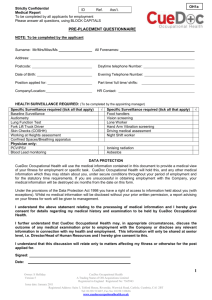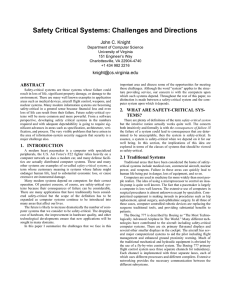Legal requirements of health data
advertisement

The legal requirements of health data Legal requirements of health data Legal requirements in regards to health data can be said to be covered by three areas of health management: 1. Organisational management of risk 2. Effects of work on health 3. Effects of health on work ensure that preventive and protective measures are in place and effective. It may be appropriate to record and analyse the results of monitoring activity, to identify any underlying themes or trends which may not be apparent from looking at events in isolation. Controlling absence numbers alone does not satisfy this requirement. 1. Organisational management of risks Regulation 5 of the Management of Health and Safety at Work Regulations as well as good practice guidance for Safety Management Systems state that an organisation should consider the roles of Planning, Organisation, Control, Monitoring and Review when managing health and safety risks. For each of these roles employers should create arrangements appropriate to the nature of their activities. Effective management of health will depend, amongst other things, on a suitable and sufficient risk assessment being carried out and the findings being used effectively. Therefore the development and management of health risk assessments, and resultant health surveillance, need to be as in depth as the health hazards require. Ignorance of the level of management required is not a defence in law. Monitoring Employers should assess how effectively they are controlling risks. Active monitoring reveals how effectively the health controls and activities are functioning; organisations should have a plan and make adequate routine inspections and checks to Review Review involves establishing priorities for necessary remedial action that were discovered as a result of monitoring to ensure that suitable action is taken. As the nature of work changes, the appreciation of hazards and risks may develop. The risk assessment may no longer be valid because, for example, the results of health surveillance, or a confirmed case of occupationally induced disease. Such events should be a trigger for reviewing the original risk assessment. In addition, a further legal requirement is for all occupational health related incidents that are reportable under RIDDOR to be reported through SMIS to the ORR. 2. Effect of work on health For the effect of work on health duty-holders should meet health-related regulatory requirements such as those specified within the following documents: Duties with interpretation due to risk assessment - Control of Substances Hazardous to Health Regulations (COSHH) 2002 - Control of Vibration at Work Regulations 2005 - Control of Noise at Work Regulations 2005 Specific duties under health - Control of Asbestos Regulations 2006. - Control of Lead at Work Regulations 2002 Legal requirements of health data The risk assessment will identify circumstances in which health surveillance is required by specific health and safety regulations eg COSHH. Health surveillance should also be introduced where the assessment shows the following criteria to apply: a) there is an identifiable disease or adverse health condition related to the work concerned; and b) valid techniques are available to detect indications of the disease or condition; and c) there is a reasonable likelihood that the disease or condition may occur under the particular conditions of work; and d) surveillance is likely to further the protection of the health and safety of the employees to be covered. The appropriate level, frequency and procedure of health surveillance should be determined by a competent person acting within the limits of their training and experience. This could be determined on the basis of suitable general guidance (eg regarding skin inspection for dermal effects) but in certain circumstances this may require the assistance of a qualified medical practitioner, occupational health hygienist or ergonomist. Health surveillance may also involve one or more procedures depending on suitability to the circumstances. Such procedures can include: a) inspection of readily detectable conditions by a responsible person acting within the limits of their training and experience; b) enquiries about symptoms, inspection and examination by a qualified person such as an Occupational Health Nurse; c) medical surveillance, which may include clinical examination and measurement of physiological or psychological effects by an appropriately qualified person; d) biological effect monitoring, ie the measurement and assessment of early biological effects such as diminished lung function in exposed workers; and e) biological monitoring, ie the measurement and assessment of workplace agents or their metabolites either in tissues, secreta, excreta, expired air or any combination of these in exposed workers. The primary benefit, and therefore objective of health surveillance should be to detect adverse health effects at an early stage, thereby enabling further harm to be prevented. The results of health surveillance can provide a means of: a) checking the effectiveness of control measures; b) providing feedback on the accuracy of the risk assessment; and c) identifying and protecting individuals at increased risk because of the nature of their work. The HSE publishes HSG61 Health surveillance at work, which is designed to give guidance on how employers can fulfill their legal duty to provide health surveillance. It is aimed at those managing health risks at work 3. The effect of health on work The primary issue to be considered is whether people can carry out their tasks in the environment without incurring foreseeable risk to themselves or to others. Fitness for work is featured within The Railways and Other Guided Transport Systems (Safety) Regulations 2006 (ROGS) (as amended). Specifically: Regulation 24: Duty to manage competence and fitness of safety critical workers Regulation 25: Duty to manage fatigue of safety critical workers Regulation 26: Co-operation requirements Manage fitness of safety critical workers Controllers of safety-critical work must: make sure an objective, trained assessor assesses safety-critical workers as being trained and fit to carry out the work; keep and update a written record of the worker’s training and fitness, including the conditions against which they were assessed; Legal requirements of health data - - make their written records available for us to inspect, or for other affected controllers or operators to inspect after making a reasonable request to do so; put in place a system to monitor the training and fitness of safety-critical workers; and review and reassess safety-critical workers’ competence or fitness if they have reason to doubt it or if the task changes significantly. or fatigue may be included in general wellbeing, especially if it does not originate from work. In regards to health data collection Wellbeing should not be seen as a legal requirement. However, data collection in this area could be of business advantage. The fitness of safety critical workers for work is framed by Railway Group Standards and managed through routine health assessments undertaken by occupational health providers. Fatigue of safety critical workers Fatigue (extreme tiredness) has been identified as one of the main causes of incidents on the railways. It can lead to workers becoming less alert or motivated, or making more mistakes or poor decisions. Controllers must make sure that workers do not carry out safety-critical tasks if they are affected by fatigue (or would be affected if they carried out the task) in a way that also affects health and safety. An effective process for managing the risks caused by fatigue in safety-critical workers should include: - Identification of the workers affected - Recording the arrangements - Monitoring of workers - Review of the arrangements Co-operation requirements for safety-critical work The co-operation requirement in ROGS builds on the existing requirement (in the Management of Health & Safety at Work Regulations 1999) for employers and self-employed people who share a workplace to co-ordinate their safety measures. This co-operation could include things like sharing information, which may include data about health. Health data collection – the current picture In regards to each of the areas specified it can be said that: Monitoring Review Health Surveillance Management of safety critical workers Are all undertaken by the organisation to meet legal requirements. The only current form of cross industry health data collection is RIDDOR reporting, which is regarded as inadequate. General well-being The legal requirements to manage General wellbeing greatly depend upon how it is defined. For issues such as obesity, smoking, and rehabilitation there are no direct legal requirements for the employer to manage. However, the commercial benefits may be considerable. On occasions stress Legal requirements of health data






